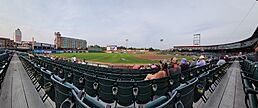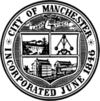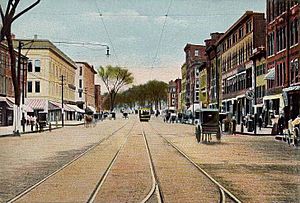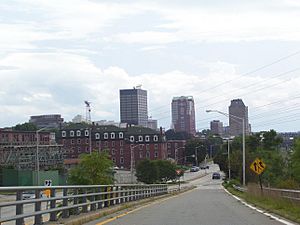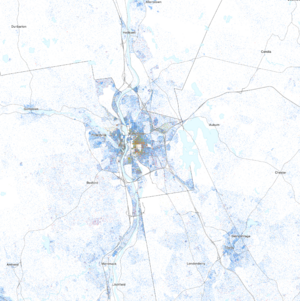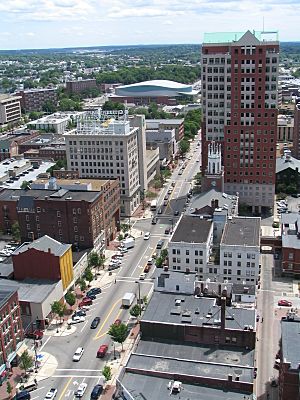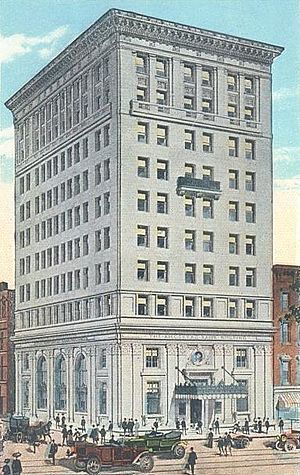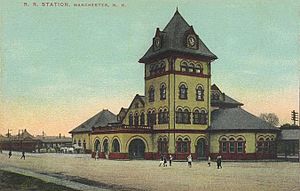Manchester, New Hampshire facts for kids
Quick facts for kids
Manchester, New Hampshire
|
||
|---|---|---|
|
|
||
|
||
| Nickname(s):
Queen City, Manch Vegas
|
||
| Motto(s):
Labor Vincit (work conquers)
|
||
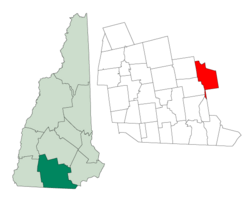
Location in Hillsborough County, New Hampshire
|
||
| Country | United States | |
| State | New Hampshire | |
| County | Hillsborough | |
| Incorporated (as Derryfield) |
1751 | |
| Incorporated (as Manchester) |
1846 | |
| Named for | Manchester, England | |
| Area | ||
| • City | 34.94 sq mi (90.48 km2) | |
| • Land | 33.07 sq mi (85.65 km2) | |
| • Water | 1.87 sq mi (4.84 km2) 5.33% | |
| • Urban | 86.1 sq mi (223.1 km2) | |
| Elevation | 210 ft (60 m) | |
| Population
(2020)
|
||
| • City | 115,644 | |
| • Rank | US: 256th | |
| • Density | 3,497.05/sq mi (1,350.23/km2) | |
| • Urban | 158,377 (US: 209th) | |
| • Urban density | 1,838/sq mi (709.8/km2) | |
| • Metro | 422,937 (US: 128th) | |
| Time zone | UTC−5 (Eastern) | |
| • Summer (DST) | UTC−4 (Eastern) | |
| ZIP Codes |
03101–03105, 03108-03109, 03111
|
|
| Area code(s) | 603 | |
| FIPS code | 33-45140 | |
| GNIS feature ID | 868243 | |
Manchester is the largest city in the state of New Hampshire, USA. It is also one of the ten biggest cities in New England. In 2020, about 115,644 people lived there. Manchester is a key city in the larger Greater Boston area.
Manchester shares the role of county seat for Hillsborough County, which is New Hampshire's most populated county. The city sits along the Merrimack River. It was named by Samuel Blodget, an inventor. He wanted to build a big industrial city, just like the original Manchester in England. That city was the world's first industrial city.
During the Industrial Revolution, Manchester was a very important center for factories and business in New England. The Amoskeag Manufacturing Company here was the biggest cotton textile factory in the world. After World War II, many textile jobs left Manchester. But new businesses, like DEKA, came to the city.
Contents
History of Manchester, New Hampshire
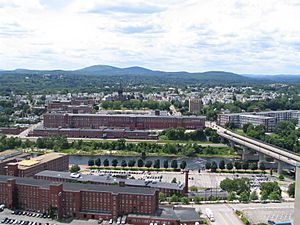
Long ago, the Pennacook Indians called this area Namaoskeag. This means "good fishing place," because of the Amoskeag Falls in the Merrimack River. In 1722, John Goffe III settled here. He built a dam and sawmill.
The area was first called Derryfield in 1751. This name is still used for a neighborhood in eastern Manchester today. In 1807, Samuel Blodget built a canal and lock system. This allowed boats to go around the falls. He dreamed of making this a huge industrial city, like Manchester in England.
In 1809, a cotton spinning mill was built. It used water power from the river. In 1810, Derryfield was renamed Manchester, just as Blodget had suggested. The mill became the Amoskeag Cotton & Woolen Manufacturing Company. Later, in 1831, it became the Amoskeag Manufacturing Company.

Amoskeag engineers planned a special "company town" on the eastern side of the river. It started in 1838 with Elm Street as its main road. Manchester became a city in 1846. It was home to the world's largest cotton mill, Mill No. 11. This mill was 900 feet (270 meters) long and 103 feet (31 meters) wide. It had 4,000 looms.
Other things made in Manchester included shoes, cigars, and paper. The Amoskeag factory also made rifles, sewing machines, and even locomotives. Many people moved to Manchester to work in the mills, especially French Canadians. Today, many residents are descendants of these workers. The Amoskeag Manufacturing Company closed in 1935. However, its old brick mills have been updated for new uses. Manchester's rich history from the 1800s left behind many beautiful Victorian buildings.
Geography and Climate
Manchester covers about 34.9 square miles (90.6 square kilometers). About 1.87 square miles (4.8 square kilometers) of this is water. The city is located along the Merrimack River. The Piscataquog River and Cohas Brook also flow through it. Lake Massabesic is on the eastern edge of the city.
The highest point in Manchester is Wellington Hill. It is about 570 feet (170 meters) above sea level.
Neighborhoods in Manchester
Manchester has 25 different neighborhoods. Some of the main ones are Amoskeag, Rimmon Heights, and Notre Dame on the West Side. On the East Side, there are the North End, Hallsville, and Bakersville.
In 2007, the city started a program to make neighborhoods better places to live. This program helps improve streets and buildings. It also helps bring back a sense of community.
Weather in Manchester
Manchester has four seasons. Winters are long, cold, and snowy. Summers are very warm and a bit humid. Spring and fall are shorter times of change.
The average temperature in January is about 24.4°F (-4.2°C). In July, it's about 72.5°F (22.5°C). On average, there are 11 days a year when the temperature goes above 90°F (32°C). About 2.9 days a year, it drops below 0°F (-18°C).
Rainfall is spread out through the year. March usually gets the most rain. Snowfall averages around 47 inches (119 cm) per season. But the amount of snow can change a lot each year.
Population and People
Manchester is the center of a larger urban area. This area had a population of 187,596 people in 2010. The Manchester-Nashua metropolitan area includes all of Hillsborough County. In 2020, it had 422,937 people. This means almost one-third of New Hampshire's population lives here.
In 2010, there were 109,565 residents in Manchester. About 26.4% of households had children under 18. The average household had 2.34 people. The average family had 2.99 people.
The city's population is diverse. In 2010, about 86.1% of residents were White. About 4.1% were Black or African American. About 3.7% were Asian. People of Hispanic or Latino background made up 8.1% of the population.
Many residents have French and French-Canadian roots (23.9%). Other large groups include Irish (19.5%), English (9.9%), German (8.6%), and Italian (8.1%).
| Historical population | |||
|---|---|---|---|
| Census | Pop. | %± | |
| 1790 | 362 | — | |
| 1800 | 557 | 53.9% | |
| 1810 | 615 | 10.4% | |
| 1820 | 761 | 23.7% | |
| 1830 | 877 | 15.2% | |
| 1840 | 3,235 | 268.9% | |
| 1850 | 13,932 | 330.7% | |
| 1860 | 20,107 | 44.3% | |
| 1870 | 23,536 | 17.1% | |
| 1880 | 32,630 | 38.6% | |
| 1890 | 44,126 | 35.2% | |
| 1900 | 56,987 | 29.1% | |
| 1910 | 70,063 | 22.9% | |
| 1920 | 78,384 | 11.9% | |
| 1930 | 76,834 | −2.0% | |
| 1940 | 77,685 | 1.1% | |
| 1950 | 82,732 | 6.5% | |
| 1960 | 88,282 | 6.7% | |
| 1970 | 87,754 | −0.6% | |
| 1980 | 90,936 | 3.6% | |
| 1990 | 99,332 | 9.2% | |
| 2000 | 107,006 | 7.7% | |
| 2010 | 109,565 | 2.4% | |
| 2020 | 115,644 | 5.5% | |
| U.S. Decennial Census | |||
| Race / Ethnicity (NH = Non-Hispanic) | Pop 2000 | Pop 2010 | Pop 2020 | % 2000 | % 2010 | % 2020 |
|---|---|---|---|---|---|---|
| White alone (NH) | 95,581 | 89,893 | 85,608 | 89.32% | 82.05% | 74.03% |
| Black or African American alone (NH) | 2,045 | 4,063 | 5,916 | 1.91% | 3.71% | 5.12% |
| Native American or Alaska Native alone (NH) | 287 | 250 | 229 | 0.27% | 0.23% | 0.20% |
| Asian alone (NH) | 2,470 | 3,993 | 4,797 | 2.31% | 3.64% | 4.15% |
| Pacific Islander alone (NH) | 31 | 41 | 27 | 0.03% | 0.04% | 0.02% |
| Some Other Race alone (NH) | 145 | 272 | 545 | 0.14% | 0.25% | 0.47% |
| Mixed Race or Multi-Racial (NH) | 1,503 | 2,170 | 4,865 | 1.40% | 1.98% | 4.21% |
| Hispanic or Latino (any race) | 4,944 | 8,883 | 13,657 | 4.62% | 8.11% | 11.81% |
| Total | 107,006 | 109,565 | 115,644 | 100.00% | 100.00% | 100.00% |
Economy and Business
Manchester is the largest city in northern New England. Its economy has changed a lot. It used to be mainly a textile mill town. Manchester is often called the "Queen City" or "Manch Vegas."
The Mall of New Hampshire is a major shopping center. It is located on the southern edge of the city. In 2001, the SNHU Arena opened. This large venue can hold over 10,000 people for concerts and sports. It has helped bring new life to downtown Manchester.
Manchester is also home to Segway, Inc.. This company makes the two-wheeled, self-balancing electric vehicle called the Segway.
Some of the biggest employers in Manchester include:
- Elliot Hospital
- Catholic Medical Center
- Southern New Hampshire University
- Eversource Energy
- FairPoint Communications
- TD Bank
- Citizens Bank
- Saint Anselm College
- Anthem Blue Cross Blue Shield
In 2021, Business Insider magazine said Manchester was one of the best cities to start a business.
Downtown Manchester Attractions
Downtown Manchester has some very tall buildings. One City Hall Plaza is 22 stories high. The Brady Sullivan Plaza is 20 stories tall. These are the tallest buildings in New England north of Cambridge, Massachusetts.
The SNHU Arena is a main attraction downtown. It can hold almost 12,000 people for concerts. It also hosts sports events and shows. The Northeast Delta Dental Stadium is a baseball park by the Merrimack River. It is home to the New Hampshire Fisher Cats, a minor league baseball team. Gill Stadium is another historic venue for sports and events.
Many old mill buildings in the Amoskeag Millyard have been updated. They are now homes, shops, and colleges. The University of New Hampshire at Manchester is one of the schools located there.
Shopping Areas
Manchester has three main shopping areas. These are downtown Manchester, South Willow Street, and Second Street on the West Side. The Mall of New Hampshire on South Willow Street has over 125 stores. It is one of the biggest shopping centers in southern New Hampshire.
Arts and Culture
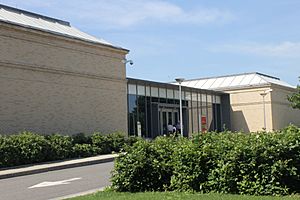
Manchester has many cultural places to visit. These include the historic Palace Theatre and the Currier Museum of Art. You can also visit the New Hampshire Institute of Art and the Manchester Historic Association Millyard Museum.
The Zimmerman House and Kalil House were designed by the famous architect Frank Lloyd Wright. The SEE Science Center is a fun place to learn about science. Valley Cemetery is a historic burial ground from 1841.
The John F. Kennedy Memorial Coliseum is a smaller venue downtown. It is home to high school hockey teams. It also hosts the Southern New Hampshire Skating Club.
The city's nickname "ManchVegas" started in the late 1980s or early 1990s. It was a joke about the city's limited entertainment options back then. But now, the city's entertainment scene has grown. The nickname has become a source of pride. In 2009, a movie called Monsters, Marriage and Murder in ManchVegas was filmed in the city.
Manchester has a growing community of artists. This is partly because of the students at the New Hampshire Institute of Art and other colleges. The Manchester City Library has served the city since the 1850s.
Chicken Tender Capital of the World
In 2022, comedian Nick Lavallee suggested that Manchester be called "The Chicken Tender Capital of the World." This idea honored the Puritan Backroom restaurant, which is said to have invented the chicken tender. Mayor Joyce Craig officially declared Manchester "The Chicken Tender Capital of the World" on July 27, 2023.
Sports and Recreation
Manchester is home to the McIntyre Ski Area, which opened in 1971. There are also college sports teams in the area. Saint Anselm College and Southern New Hampshire University have teams that play in the NCAA Division II Northeast-10 Conference. The school with the most wins against each other each year earns the Queen City Cup.
Professional Sports Teams
Manchester is the only city in New Hampshire with professional sports teams. The New Hampshire Fisher Cats baseball team plays at Delta Dental Stadium. They are a minor league team for the Toronto Blue Jays. The New Hampshire Kingz basketball team plays in the ABA.
From 2001 to 2015, the Manchester Monarchs played in the American Hockey League. They won the league championship in their last season. From 2015 to 2019, a different Monarchs team played in the ECHL. Both hockey teams played at the SNHU Arena.
Education in Manchester
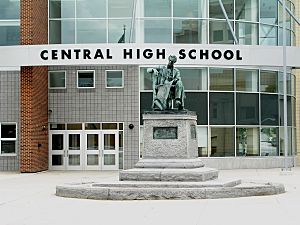
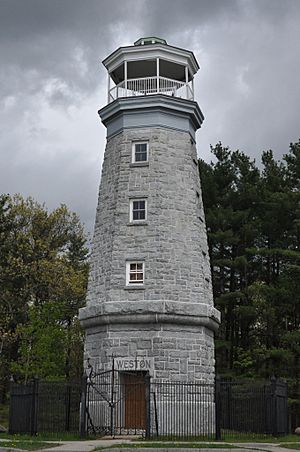
Public Schools
The Manchester School District runs the public schools. Manchester has four public high schools:
- Manchester High School West
- Manchester High School Central
- Manchester Memorial High School
- Manchester School of Technology
There are also four public middle schools and fourteen elementary schools.
Private and Charter Schools
Manchester has several private high schools:
- Trinity High School (Catholic)
- The Derryfield School (grades 6-12)
- Holy Family Academy (Catholic, grades 7-12)
There are also several charter schools, which are public schools that operate independently:
- The Founders Academy (grades 6-12)
- Making Community Connections Charter School Manchester Campus (MC2) (grades 6-12)
- Mills Falls Charter School (Montessori education, K-6)
- Polaris Charter School (elementary)
- Kreiva Academy (grades 6-12)
Colleges and Universities
More than 8,000 students attend colleges and universities in the Manchester area. These include:
- Franklin Pierce University, Manchester campus
- Granite State College, Manchester campus
- Hellenic American University
- Manchester Community College
- Massachusetts College of Pharmacy and Health Sciences, Manchester campus
- New Hampshire Institute of Art
- Southern New Hampshire University
- University of New Hampshire at Manchester
Saint Anselm College is very close to the city limits. It has a Manchester mailing address.
Media and News
The city has several news sources. These include the New Hampshire Union Leader newspaper, The Hippo (a local weekly), and Manchester Ink Link.
Radio Stations
Many radio stations serve the Manchester area. Some of them are:
- WEVO 89.1 (NPR), "New Hampshire Public Radio")
- WLMW 90.7 (religious programming)
- WDER-FM 92.1 (Christian programming)
- W231BR (classic hits)
- WMNH (Public Access - 95.3)
- WZID 95.7 (adult contemporary)
- WMLL 96.5 (classic hits)
- WOKQ 97.5/97.9 (country music)
- WNNH 99.1 (active rock)
- WGIR-FM 101.1 (rock music)
- W276BJ 103.1 (country music)
- WBNH-LP 105.1 (alternative rock)
- WJYY 105.5 (top 40)
- WFNQ 106.3 (Adult Contemporary)
- W295BL 106.9 (classical music)
- WTPL 107.7 (news/talk and sports)
You can also hear many radio stations from Boston in Manchester.
Television Channels
Manchester is part of the Boston television market. Here are some TV stations based in the Greater Manchester area:
| Channel | Callsign | Affiliation | Branding | Subchannels | Owner | |
|---|---|---|---|---|---|---|
| (Virtual) | Channel | Programming | ||||
| 9.1 | WMUR-TV | ABC | WMUR ABC 9 | 9.2 |
MeTV |
Hearst Television |
| 15.1 | WBTS-CD | NBC | NBC 10 Boston | 15.2 |
Cozi TV |
NBCUniversal |
| 21.1 | WPXG-TV | Ion | Ion | 21.2 21.3 21.4 21.5 21.6 |
Qubo Ion Plus ION Shop QVC HSN |
Ion Media Networks |
| 50.1 | WWJE-DT | True Crime Network | Univision Communications | |||
| 60.1 | WNEU | Telemundo | Telemundo Boston | 60.2 |
TeleXitos |
NBCUniversal |
Transportation and Travel
Air Travel
The Manchester-Boston Regional Airport serves the city. It is the fourth-largest passenger airport in New England.
Roads and Highways
Several major roads go through Manchester:
- Interstate 93
- Interstate 293
- U.S. Route 3
- New Hampshire Route 3A
- New Hampshire Route 28
- New Hampshire Route 28A
- NH 28 Bypass
- New Hampshire Route 101
- New Hampshire Route 114A
Bus Services
The Manchester Transit Authority (MTA) runs local bus routes. It also has "Zip Line" express buses to Concord, Nashua, and Salem. Greyhound Lines offers bus service to other cities in the Northeast.
Train Service Plans
In the past, trains ran from Manchester to places like Boston and Montreal. The last regular train service ended in 1967.
There are plans to bring back train service. The MBTA Commuter Rail might extend its Lowell Line to Manchester. This would connect Manchester to Boston by train. A study is being done to plan this project. The proposed Manchester station would be near the Market Basket grocery store on Elm Street.
There are also ideas for a special rail loop in downtown Manchester and the Millyard. This loop would be about three miles long. It would connect different parts of the city. In 2021, Amtrak also announced plans for new service from Boston to Concord, including a stop in Manchester, by 2035.
Notable People from Manchester
Many interesting people have come from Manchester. You can find a list of them in the main article.
Sister Cities
Manchester has two sister cities:
 Neustadt an der Weinstraße, Germany
Neustadt an der Weinstraße, Germany Taichung, Taiwan
Taichung, Taiwan
See also
 In Spanish: Mánchester (Nuevo Hampshire) para niños
In Spanish: Mánchester (Nuevo Hampshire) para niños








